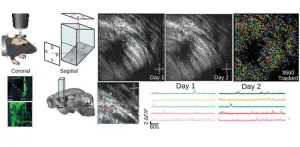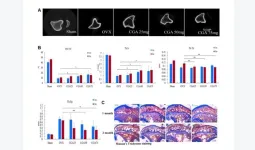(Press-News.org) COLUMBUS, Ohio – When the skeletal remains of a giant ground sloth were first unearthed in 1796, the discovery marked one of the earliest paleontological finds in American history.
The animal, named Megalonyx by Thomas Jefferson in 1799, was the first genus of fossil named from the United States. Thought to have roamed North America during one of the last ice ages, the extinct giant ground sloth was an herbivorous mammal resembling a large bear — at full size, it likely reached nearly 10 feet tall (3 meters) and weighed about as much as a small elephant.
The report made by Jefferson, an avid fossil collector who was known to keep bones at the White House, was among the earliest papers in the scientific field that would eventually become paleontology, and may have played a role in the development of certain zoological naming conventions.
Though Jefferson named only the genus Megalonyx, public misinterpretation of the spelling of the scientific name began with the second published paper on this giant ground sloth. Later on, confusion about the true author and timing of the report caused paleontologists to debate over what the specimen’s true name should be.
In an effort to settle the dispute, Loren Babcock, a professor of earth sciences at The Ohio State University, reviewed the nomenclatural history of the animal and argues that misinterpretation or spelling errors of the original harm the scientific process and disregard the importance of early paleontological work.
In an article published recently in the journal ZooKeys, Babcock asserts that since Jefferson fulfilled all the necessary requirements for establishing the formal zoological name of the giant ground sloth, he should be recognized as the true author of the genus. And because Jefferson’s original moniker was spelled as Megalonyx, any other subsequent spellings of the name, like some that utilize the -onix suffix, are incorrect. Additionally, the report notes that the original spelling of the animal’s species-group name, Megalonyx jeffersonii, is only correct when written with an –ii ending.
“At the time, there were no standards for publication of new names in zoology,” said Babcock. “There was a binomial system of nomenclature, a genus and species name that would be attached to things, but there were no rules other than that.”
Today, when a new species is discovered, scientists give it a name with two parts: The first name describes the animal’s genus, or group, and the second is its species name. Until the mid-1800s, it was common practice to label animals with only a genus name, which is how Jefferson’s original paper described Megalonyx. Although his observations were published more than a quarter century before paleontology was considered a formal science, it does meet modern naming requirements – meaning his authorship of it is valid, said Babcock.
“We have rules in science just like we do in other aspects of our culture,” said Babcock. “They ensure that the correct procedures are followed and we can give credit where it is due.”
Resolving some of these long-standing issues is important, Babcock said, and it’s worth setting the record straight. “I want to set the original usage in stone because Jefferson had done it correctly from the start,” said Babcock. “It’s pretty black and white. There’s not much room for ambiguity when you go back and read the original manuscripts.”
In the long run, having strict naming conventions also helps scientists accurately document the history of life on Earth, because what paleontologists choose to call a specimen can have profound implications for how it’s studied and how those findings are communicated.
Megalonyx jeffersonii, for instance, was initially mistaken as a carnivore when its “giant claw” was compared to that of a large African lion. Jefferson soon corrected this, but his initial observations of the giant ground sloth’s remains contributed to the way that Megalonyx would later be reconstructed and influenced some of the earliest developments of the discipline, and earned him the title of father of American paleontology, said Babcock.
Decades later, the first relatively complete skeleton of Megalonyx jeffersonii was found in 1890 in Holmes County, Ohio. “This skeleton has had a major impact on the history of science,” Babcock said. “It’s really influenced so much of the perception of paleontology and paleontological art over time.”
As one of the earliest free-standing prehistoric specimens to be mounted and displayed in an American museum, it’s been used as a unique learning tool for past and future paleontologists alike. It was also a model that was later applied for dinosaur skeleton reconstructions, said Babcock. This popularity has led many other versions of Megalonyx jeffersonii to appear across digital media and pop culture throughout the past century, most notably in the “Ice Age” films as Sid the ground sloth.
Today, the reconstructed skeleton of Megalonyx jeffersonii resides in Ohio State’s Orton Geological Museum, where it has been on display since April 13, 1896. And for decades, it’s been known by many as simply “Jeff” for short.
Although few truly know all the details of its backstory, Babcock, who is the current director of the Orton Museum, remains confident that the legacy of Thomas Jefferson’s Megalonyx jeffersonii will stand tall for centuries to come.
“Understanding the history of paleontology casts light not just on the evolution of organisms, but on the evolution of science and how we interpret that evolutionary history,” he said. “So names are something that I think historians will always pay attention to.”
#
Contact: Loren Babcock, Babcock.5@osu.edu
Written by: Tatyana Woodall, Woodall.52@osu.edu
END
Organisms constantly face the challenge of adapting their behavior to survive in a world full of uncertainties. This ability relies on complex neural circuits in the brain that help them find resources while avoiding danger. Scientists study how these neural circuits change over time to understand better how behaviors emerge.
One powerful way to study these changes is through optical imaging techniques that allow researchers to track the activity of individual brain cells. Traditional methods rely on observing the activity of cells directly, ...
“[...] chlorogenic acid appears to be a promising candidate for the management of osteoporosis.”
BUFFALO, NY- March 26, 2024 – A new research paper was published in Aging (listed by MEDLINE/PubMed as "Aging (Albany NY)" and "Aging-US" by Web of Science) Volume 16, Issue 5, entitled, “Chlorogenic acid prevents ovariectomized-induced bone loss by facilitating osteoblast functions and suppressing osteoclast formation.”
Osteoporosis is a common bone disease in ...
Researchers at Weill Cornell Medicine have discovered a protein called SEL1L that plays a critical role in clearing collagen from tissue, and which may be a therapeutic target to help prevent fibrosis, scar tissue that interferes with organ function. The paper, published on Feb. 20 in Nature Communications, provides clues that could lead to drug development for diseases like lung fibrosis which have no therapeutic options currently.
Corresponding author, Dr. Michael J. Podolsky, assistant professor of medicine at Weill Cornell Medicine, has led a team that searched the human genome for genes involved in the ...
FOR IMMEDIATE RELEASE
Recent historical, political and public health events, most notably the COVID-19 pandemic, have collectively contributed to increased stress and mental health challenges among many groups of people — including adolescents in racial and ethnic minorities.
In a study published Feb. 1 in Academic Pediatrics, Johns Hopkins Children’s Center researchers investigated the pandemic’s effect on preexisting mental health disparities among youth, and found rates of depression, anxiety, and suicidal thoughts and behaviors ...
By 2030, the World Health Organization (WHO), the Global Fund and UNAIDS are hoping to end the human immunodeficiency virus (HIV) and AIDS epidemic. An international team of researchers led by Eric Arts, professor at the Schulich School of Medicine & Dentistry, and Jamie Mann, senior lecturer at the University of Bristol (U.K.), has brought us another step closer to meeting this goal, by finding an effective and affordable targeted treatment strategy for an HIV cure.
In a first, the study published ...
Leuven (Belgium) 26 March 2024 - Belgian scientists have developed AI models that can predict how a particular beer will be rated by consumers, and what aroma compounds brewers can add to improve it. The research was published today in the renowned scientific journal Nature Communications and may revolutionize how the food and beverage industry develops new products.
Tricky to compare
Comparing and ranking flavor profiles of different beers is a challenge. There are a multitude of guides on the market describing ...
Grapes grown to make wine are sensitive to climate conditions such as temperature and extreme drought. These effects are already visible worldwide on yields, the composition of grapes and the quality of wines, with already and soon-to-be-observed consequences on the geography of wine production. Understanding shifts in wine production potential due to climate change is a major scientific concern. Based on their expertise and a thorough analysis of the scientific literature — over 250 publications in the last 20 years – a research team has established a global map of evolving trends in the threats and potential benefits that climate change brings ...
SAN ANTONIO — March 26, 2024 —Southwest Research Institute Senior Research Scientist Dr. Rohini Giles has received the NASA Early Career Achievement Medal. The medal recognizes unusual and significant performance supporting NASA’s mission during the first 10 years of their career. Giles was cited for “significant early career achievements in the analysis of Juno data to study Jovian Transient Luminous Events and the distribution of constituents in Jupiter’s atmosphere.”
“It’s ...
About The Study: In this cohort study of 64,000 low-income Americans, nearly 80% of study participants consumed sodium exceeding the current recommended daily amount, which was associated with 10% to 30% of cardiovascular disease mortality. Public health programs targeted to reduce sodium intake among this underserved population may be beneficial.
Authors: Xiao-Ou Shu, M.D., Ph.D., of the Vanderbilt University School of Medicine in Nashville, is the corresponding author.
To access the embargoed study: Visit our For The Media website at this link https://media.jamanetwork.com/
(doi: 10.1001/jamanetworkopen.2024.3802)
Editor’s Note: Please see the ...
About The Study: In this cohort study including 309,000 Danish children, longer duration of exclusive breastfeeding was associated with reduced risk of childhood B-cell precursor-acute lymphoblastic leukemia, corroborating results of previous case-control investigations in this field. To inform future preemptive interventions, continued research should focus on the potential biologic mechanisms underlying the observed association.
Authors: Signe Holst Søegaard, Ph.D., of the Danish Cancer Society in Copenhagen, is the corresponding ...






